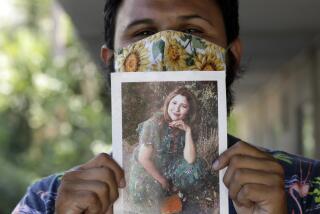Panel Urges L.A. to Pay $737,500 to Victim of 1981 Chatsworth Crash
- Share via
A Los Angeles City Council committee Tuesday approved a $737,500 out-of-court settlement with a former physical therapist who suffered permanent brain damage in a two-car accident at a Chatsworth intersection six years ago.
The negotiated settlement for Maria Berwaldt and her family came on the recommendation of City Atty. James K. Hahn. A rash of “almost identical” accidents have occurred at the same intersection where Berwaldt was injured, Hahn said, and if the case went to trial he fears that the city might be found liable for millions in damages.
If approved by City Council and Mayor Tom Bradley, the settlement would be paid through the city’s liability fund.
Berwaldt, 33, was a passenger in a car northbound on Oakdale Avenue on Jan. 17, 1981. The driver failed to heed a stop sign and the car was struck by a vehicle eastbound on Prairie Street, said Philip Sugar, assistant city attorney.
The driver of the second vehicle was killed and the person driving the vehicle in which Berwaldt was a passenger was seriously injured. Neither driver was identified by the city attorney at Tuesday’s committee meeting.
The suit brought by Berwaldt’s family was the only one filed against the city in connection with the accident. In its suit, the family said Berwaldt was in a coma for 2 1/2 months and can no longer feed or bathe herself, cannot speak more than a few garbled words and is “mentally functioning at the level of a grammar school student,” according to the city attorney’s report to the council.
Maria Berwaldt’s husband, Walter, claimed a loss of consortium because of his wife’s injuries. Her doctors estimated that lifetime medical care in current dollars will cost $3 million.
In the suit, Berwaldt’s family contended that the city was largely at fault because the intersection of Oakdale and Prairie was poorly designed and dangerous.
At the time, the intersection was part of a newly developed commercial and industrial area that had no structures. During excavation for the streets and lots, a four-foot-high embankment of dirt, covered with brush and weeds, was piled along both Oakdale and Prairie, Sugar said. The dirt mound made it difficult for vehicles on one street to see cross traffic.
Until last year, no speed-limit signs were posted, therefore the assumed limit was 55 m.p.h., Sugar said.
Although Berwaldt’s accident was the first recorded at that intersection, 23 other accidents occured there from January, 1981, to November, 1983. Fourteen of those were “almost identical” to Berwaldt’s accident, Sugar said.
Sugar said a jury would probably find the city guilty of “creation of a dangerous and defective intersection” because of the many similar accidents at the location.
Several changes have been made at the intersection since 1983, including switching from two-way to four-way stop signs and posting of a 30-m.p.h. speed limit. Since those changes, there have been only three accidents, Sugar said.
More to Read
Sign up for Essential California
The most important California stories and recommendations in your inbox every morning.
You may occasionally receive promotional content from the Los Angeles Times.










